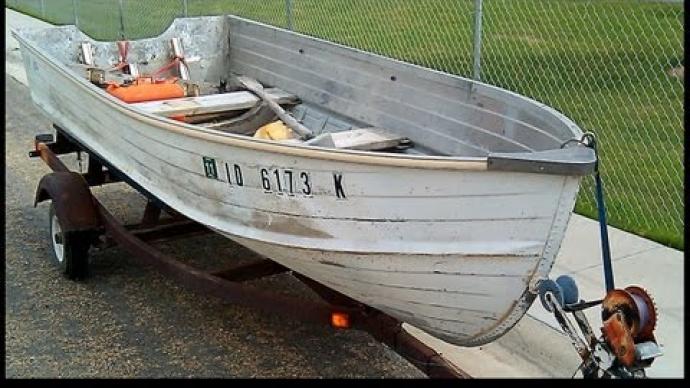| Tools |
| - Tape measure |
| - Scraper (to remove excess glue) |
| - Regular screwdriver or chisel (to break rivets) |
| - Small hammer |
| - Acetone (to remove old glue) |
| - Newspaper (to cut template for new carpet) |
| - Chemical resistant gloves |

One of the problems with buying used bass boats or keeping a boat past its prime is replacing the old, worn-out carpet. Any boat will look 100 percent better with a fresh deck of carpet, but many anglers get frustrated with such a project, and rightly so. I still own the first bass boat I'd ever bought, a 1979 King Cobra, and have replaced the carpeting three times in 23 years. Each time we have replaced the carpet, my wife has played an integral part. I suggest any sort of bribe, or act of kindness, that will net you the proper assistance from your spouse. Trust me. It will make your recarpeting project a whole lot easier.
Now that you've enlisted some help, it's time to start. First, you must remove the old carpet. This can be the most challenging part of the project because manufacturers use no universal method to install carpets. Some use paste glue; others use spray-on adhesives. Plus, some boat builders use a lower quality carpet in their boats. Combining poor carpet and paste glue can complicate getting that old carpet out.
Don't waste your money on over-the-counter glue removers. I've yet to find one that works. Instead, one readily available chemical works best for lifting old carpet out of the boat. To be sure, this chemical should be handled with EXTREME CARE, and chemical-resistant gloves are mandatory. The chemical is acetone. It can be purchased by the quart or gallon in paint supply or hardware stores. A little acetone mixed with the glue was poured on the carpet mixed with the glue, and helped release its grip on the carpet. Another bonus for acetone: it evaporates quickly and usually doesn't make too big of a mess. A 4- to 6-inch sheetrock blade, used as a scraper, removes any glue or carpet residue from the deck.
My old boat has separate compartment lids that make up the walking deck. To get the carpet and glue residue from these lids, you must first remove the piano hinges from the lids themselves. Your boat may be put together differently, but most boats use either aluminum pop rivets to hold the hinges or stainless steel screws. My boat originally used pop rivets, but in the first recarpet job, performed in 1985, we replaced the pop rivets with screws.
To remove pop rivets, especially those made of aluminum, take the tip of a regular screwdriver and, with a small hammer, tap down lightly against the rivet. The aluminum gives way quickly, and the rivet will break in two. If you have steel pop rivets, good luck-you may need to add a hacksaw to the list of tools.
With all the compartment lids removed, cleaned, and laid out flat on the cement or lawn, it's time to buy, cut, and install the new carpet.
Purchasing a new carpet should be fine, but don't be suckered into buying one that won't hold up to the rigors of bass fishing. We once made the mistake of using a discount outdoor/indoor carpet from a national hardware store, and much to our dismay, the carpet lasted only two years. Buy the best indoor/outdoor carpeting you can find. I recommend searching for a marine store, waiting for some carpeting to go on sale, or biting the bullet and getting the best you can. With the amount of work involved in this project, the carpet cost shouldn't be a factor. For example, the carpet for my 16-foot King Cobra cost $130.
For adhesive, I recommend a spray-on adhesive manufactured by 3M. It comes in a spray can and costs around 12 dollars per can. For my project, I purchased two cans to ensure I had enough.
There is no secret to cutting the carpet. Always cut the largest piece first to know what is left over for the compartment lids. On my boat, the floor takes the most carpet. After cutting that to size, I cut the compartment lids by spreading the carpet out on a hard surface and then laying the lids on top of the carpet. My lids were designed to have the carpet drape over the sides and adhere underneath. A template, cut and taped from old newspapers, works very well for lids and decks that must be cut more accurately. Then, all the cuts can be made using the flat template on top of the carpet. Any good utility or vinyl knife will do for cutting.
Once the carpet is cut, test the spray adhesive on one of the smaller compartment lids for strength and permanency. Don't test the largest piece in case you have a surface that won't bond. I've never had that problem, but it's better to be safe than sorry.
After the test, lay the floor first, then all the deck lids. Remember which side of the lids the piano-hinge holes are on. After laying the carpet, replace the screws or pop rivets, plus the hinges, and put your boat back together.
Each time we replaced the carpet in our boat, the project took between 6 and 10 hours to complete, start to finish. Our problem is that we can't seem to spend 10 hours in one shift, so our boat is usually dismantled for a couple of weeks while we get it all done. Good Luck!
Reprinted with permission from Bass West Magazine


